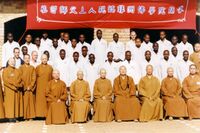Spread of Zohism: Difference between revisions
mNo edit summary |
|||
| Line 49: | Line 49: | ||
[[File:PadarathaProcession.jpg|thumb|700px|center|<center>A panorama showing the [[Night Procession (Padaratha)|Night Procession]] of [[Jata Tala|Ivang Jata Tala]] of the [[Tangura Pakalas]].</center>]] | [[File:PadarathaProcession.jpg|thumb|700px|center|<center>A panorama showing the [[Night Procession (Padaratha)|Night Procession]] of [[Jata Tala|Ivang Jata Tala]] of the [[Tangura Pakalas]].</center>]] | ||
{{multiple image|caption_align=center|total_width= | As with the rest of Satria, Zohism arrived in the area comprising modern-day Padaratha, often referred to as [[Tankar Nadu]], in the 6th century BCE. These initial Zohists were refugees from Xiang persecution, who sought to establish communities. Though at the start they likely proselytised and formed self-sufficient communities, their lack of access to a wider Zohist community and clergy resulted in heterodox beliefs and extreme syncretism with local religions. Over time their small numbers, particularly in far-off Tankar Nadu, meant that they were largely assimilated and ceased to exist by the time later Zohist traders and missionaries arrived.{{multiple image|caption_align=center|total_width=250|perrow=2 | ||
| title = Notable [[Zohist deities|Devas]] in [[Zohism in Satria|Satrian Zohism]] | | title = Notable [[Zohist deities|Devas]] in [[Zohism in Satria|Satrian Zohism]] | ||
| image1 = Kali_by_Raja_Ravi_Varma.jpg | alt1=Kali| caption1 = [[Kali]] | | image1 = Kali_by_Raja_Ravi_Varma.jpg | alt1=Kali| caption1 = [[Kali]] | ||
| Line 56: | Line 56: | ||
| image4 = GauriZohism.png | alt4=Gauri | caption4=[[Gauri]] | | image4 = GauriZohism.png | alt4=Gauri | caption4=[[Gauri]] | ||
}} | }} | ||
The conversion of the Xiang dynasty under Emperor Min in the 1st century, and its establishment as the state religion of various Shangean dynasties, gave Zohism the ability to establish a centre from which to spread out from. The first Zohist missionaries are recorded arriving in Tankar Nadu in the 3rd century CE, most of them directly from Shangea. Their impact was limited, as the highly orthodox Tsandau school they espoused allowed little room for indigenous rituals, beliefs, deities, and clergy to fuse with their stricter interpretation of Zohism. As a result of this, and their focus on the [[Bashurat Delta]], they remained a small and largely urban minority in the Tankar Nadu region. While they received some patronage from monarchs they largely had to survive on donations from monasteries in Shangea, and Shangean emperors. | |||
===Rahelia=== | ===Rahelia=== | ||
Revision as of 17:45, 13 September 2021
| Part of a series on |
| Zohism |
|---|
 |
Since its beginning over 2600 years ago, Zohism has found converts and followers across the world, though it is most prevalent in South and Southeast Coius. Following the death of its founder, Soucius, his followers radiated out across Coius to find refuge from persecution and found communities. The conversion of Emperor Min both removed persecution and elevated Zohism to a state religion of the Xiang dynasty. Under the patronage of successive Shangean dynasties such as the Sun and Tao it saw a significant expansion across South Coius. The emulation of Shangean traditional governance and administration resulted in Zohism's spread outwards for a second time from its core in central Shangea. Aside from this, merchants and missionaries played a large role in proselytising to both rulers and communities. For the former conversion to Zohism, even nominally, was very attractive as it brought increased trade and relations with Shangea, as well as access to Zohist monks who could import Shangean technology, literature, and the system of Sengshui.
Numerous Zohist polities, states, and dynasties have existed since its foundation. Some of the earliest states were those of the Xiang-Shan Contention in Shangea's early history, the kingdoms of Tan, Xi, and Zhan, all of which were short-lived in their conversions, or were later conquered by the Xiang. The Later Xiang and subsequent dynasties would be powerful centres of Zohism. The Svai Empire, Senrian Empire, Ansan Empire, Kingdom of Myiang, Kasi Kingdoms of Lanhok and Sippom, Lương dynasty, Pakala kingdoms, Kingdom of Nakha and Khaunban Empire were significant Zohist states or patrons of the religion.
As of 2021 Zohism is the second largest religion in the world, with over 655 million adherents. It is the second fastest growing religion, behind Sotirianity, and if current trends continue is expected to reach a billion adherents by the year 2100.
History
Discupuline Zohism
Xiang to Tao
Conversion within Shangea: Xiang, Sun, and Tao
From persecution to power
Medieval and Early-modern Zohism
Modern
By region
South Coius
Shangea
Ansan
Duran
Senria
Southeast Coius
Siamat
Kuthina
Nainan
Brown Sea
Satria
Padaratha

As with the rest of Satria, Zohism arrived in the area comprising modern-day Padaratha, often referred to as Tankar Nadu, in the 6th century BCE. These initial Zohists were refugees from Xiang persecution, who sought to establish communities. Though at the start they likely proselytised and formed self-sufficient communities, their lack of access to a wider Zohist community and clergy resulted in heterodox beliefs and extreme syncretism with local religions. Over time their small numbers, particularly in far-off Tankar Nadu, meant that they were largely assimilated and ceased to exist by the time later Zohist traders and missionaries arrived.
The conversion of the Xiang dynasty under Emperor Min in the 1st century, and its establishment as the state religion of various Shangean dynasties, gave Zohism the ability to establish a centre from which to spread out from. The first Zohist missionaries are recorded arriving in Tankar Nadu in the 3rd century CE, most of them directly from Shangea. Their impact was limited, as the highly orthodox Tsandau school they espoused allowed little room for indigenous rituals, beliefs, deities, and clergy to fuse with their stricter interpretation of Zohism. As a result of this, and their focus on the Bashurat Delta, they remained a small and largely urban minority in the Tankar Nadu region. While they received some patronage from monarchs they largely had to survive on donations from monasteries in Shangea, and Shangean emperors.





